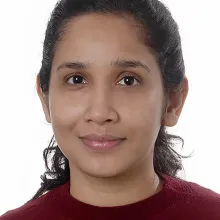
Adamska Group - Genomic and evolutionary basis of animal development
Our research is aimed at uncovering the genetic and genomic basis of morphological complexity in animals, from both developmental and evolutionary perspectives.
About
Our research is aimed at uncovering the genetic and genomic basis of morphological complexity in animals, from both developmental and evolutionary perspectives. From the developmental perspective, we are interested in the early stages of development, including symmetry breaking during formation of the embryo and then during growth of the organisms. From the evolutionary perspective, we are interested in both macroevolutionary transitions (from colonial protists to the first animals, and from simple to complex animals), as well as in microevolutionary transitions (body form variations among related species). We are using marine sponges as primary model species, and a variety of animals (especially cnidarians) and their relatives in comparative analyses. Our work combines a bit of field sampling with lots of next-generation sequencing, gene and protein expression analyses and experimental manipulations of sponges, including studies of regeneration.
We are also very keen to share our excitement about marine models in biology - explore many of them (including sponges!) here:
https://digital-marine.sorbonne-universite.fr/index.php/digitalmarine
Publications
Research papers
- Voigt O, Adamska M, Adamski, Kittelmann A, Wencker L, Wörheide G (2017) Spicule formation in calcareous sponges: Coordinated expression of biomineralization genes and spicule-type specific genes. Sci Rep, 7:45658.
- Ueda N, Richards GS, Degnan BM, Kranz A, Adamska M, Croll RP, Degnan SM. 2016. An ancient role for nitric oxide in regulating the animal pelagobenthic life cycle: evidence from a marine sponge. Sci Rep. 6:37546.
- Fortunato SA, Vervoort M, Adamski M, Adamska M. 2016. Conservation and divergence of bHLH genes in the calcisponge Sycon ciliatum. Evodevo. 7:23.
- Borisenko I, Adamski M, Ereskovsky A, Adamska M. 2016. Surprisingly rich repertoire of Wnt genes in the demosponge Halisarca dujardini. BMC Evol Biol. 16:123.
- Lavrov DV, Adamski M, Chevaldonné P, Adamska M. 2016. Extensive Mitochondrial mRNA Editing and Unusual Mitochondrial Genome Organization in Calcaronean Sponges. Curr Biol. 26:86-92.
- Bråte J, Adamski M, Neumann RS, Shalchian-Tabrizi K, Adamska M. 2015. Regulatory RNA at the root of animals: dynamic expression of developmental lincRNAs in the calcisponge Sycon ciliatum. Proc Biol Sci. 282(1821). pii: 20151746
- Borisenko IE, Adamska M, Tokina DB, Ereskovsky AV. 2015. Transdifferentiation is a driving force of regeneration in Halisarca dujardini (Demospongiae, Porifera). PeerJ. 3:e1211
- Voigt O, Adamski M, Sluzek K, Adamska M. 2014. Calcareous sponge genomes reveal complex evolution of alpha-carbonic anhydrases and two key biomineralization enzymes. BMC Evolutionary Biology, 14:230.
- Fortunato S, Adamski M, Mendivil O, Leininger S, Liu J, Ferrier DEK and M Adamska. 2014. Calcisponges have a ParaHox gene and dynamic expression of dispersed NK homeobox genes. Nature, 514, 620–623.
- Fortunato S, Leininger S and M Adamska. 2014. Evolution of the Pax-Six-Eya-Dach network: the calcisponge case study. EvoDevo 5:23.
- Leininger S, Adamski M, Bergum B, Guder C, Liu J, Laplante M, Bråte J, Hoffmann F, Fortunato S, Jordal S, Rapp HT and Adamska M. 2014. Developmental gene expression provides clues to relationships between sponge and eumetazoan body plans. Nature Comm. 5:3905
- Zakrzewski A-C, Weigert A, Helm C, Adamski M, Adamska M, Bleidorn C, Raible F, Hausen H. 2014. Early divergence, broad distribution and high diversity of animal chitin synthases. Genome Biol Evol 6(2):316–325
- Sebé-Pedrós A, Ariza-Cosano A, Weirauch MT, Leininger S, Yang A, Torruella G, Adamski M, Adamska M, Hughes TR, Gómez-Skarmeta JL, Ruiz-Trillo I. 2013. Early evolution of the T-box transcription factor family. PNAS 110(40):16050-16055.
- Gazave E, Lavrov DV, Cabrol J, Renard E, Rocher C, Vacelet J, Adamska M, Borchiellini C, Ereskovsky AV. 2013. Systematics and molecular phylogeny of the family oscarellidae (homoscleromorpha) with description of two new oscarella species. PLoS One. 8(5):e63976.
- Nosenko T, Schreiber F, Adamska M, Adamski M, Eitel M, Hammel J, Maldonado M, Müller WE, Nickel M, Schierwater B, Vacelet J, Wiens M, Wörheide G. 2013. Deep metazoan phylogeny: When different genes tell different stories. Mol Phylogenet Evol. 67(1):223-33.
- Robinson JM, Sperling EA, Bergum B, Adamski M, Nichols SA, Adamska M, Peterson KJ. 2013. The Identification of MicroRNAs in Calcisponges: Independent Evolution of MicroRNAs in Basal Metazoans. J Exp Zool B Mol Dev Evol. 320(2):84-93
- Hill MS, Hill AL, Lopez J, Peterson KJ, Pomponi S, Diaz MC, Thacker RW, Adamska M, Boury-Esnault N, Cárdenas P, Chaves-Fonnegra A, Danka E, De Laine BO, Formica D, Hajdu E, Lobo-Hajdu G, Klontz S, Morrow CC, Patel J, Picton B, Pisani D, Pohlmann D, Redmond NE, Reed J, Richey S, Riesgo A, Rubin E, Russell Z, Rützler K, Sperling EA, di Stefano M, Tarver JE, Collins AG. 2013. Reconstruction of Family-Level Phylogenetic Relationships within Demospongiae (Porifera) Using Nuclear Encoded Housekeeping Genes. PLoS One.;8(1):e50437
- Fortunato S, Adamski M, Bergum B, Guder C, Jordal S, Leininger S, Zwafink C, Rapp HT, Adamska M 2012. Genome-wide analysis of the Sox family in the calcareous sponge Sycon ciliatum: multiple genes with unique expression patterns. EvoDevo, 3:14
- Adamska, M., Larroux, C., Adamski, M., Green, K., Lovas, E., Koop, D., Richards, G.S., Zwafink, C., Degnan, B.M., 2010. Structure and expression of conserved wnt pathway components in the demosponge Amphimedon queenslandica. Evolution & Development 12 (5), 494-518.
- Srivastava, M., Simakov, O., Chapman, J., Fahey, B., Gauthier, M.E.A., Mitros, T., Richards, G.S., Conaco, C., Dacre, M., Hellsten, U., Larroux, C., Putnam, N. H., Stanke, M., Adamska, M., Darling, A., Degnan, S. M., Oakley, T. H., Plachetzki, D. C., Zhai, Y., Adamski, M., Calcino, A., Cummins, S. F., Goodstein, D. M., Harris, C., Jackson, D. J., Leys, S. P., Shu, S., Woodcroft, B. J., Vervoort, M., Kosik, K. S., Manning, G., Degnan, B. M., & Rokhsar, D. S. 2010. The Amphimedon queenslandica genome and the evolution of animal complexity. Nature 466(7307), 720-726.
- Richards, G.S., Simionato, E., Perron, M., Adamska, M., Vervoort, M., Degnan, B.M. 2008. Sponge genes provide new insight into the evolutionary origin of the neurogenic circuit. Curr. Biol. 18, 1156-1161.
- Chow CY, Zhang Y, Dowling JJ, Jin N, Adamska M, Shiga K, Szigeti K, Shy ME, Li J, Zhang X, Lupski JR, Weisman LS, Meisler MH. Mutation of FIG4 causes neurodegeneration in the pale tremor mouse and patients with CMT4J. 2007. Nature. Jul 5; 448(7149):68-72.
- Sakarya O, Armstrong KA, Adamska M, Adamski M, Wang IF, Tidor B, Degnan BM, Oakley TH, Kosik KS. 2007. A post-synaptic scaffold at the origin of the animal kingdom. PLoS ONE. Jun 6;2(6):e506.
- Erpenbeck D, Voigt O, Adamski M, Adamska M, Hooper JN, Wörheide G, Degnan BM. 2007. Mitochondrial diversity of early-branching metazoa is revealed by the complete mt genome of a haplosclerid demosponge. Mol Biol Evol. 24(1):19-22.
- Adamska M, Matus DQ, Adamski M, Green K, Rokhsar DS, Martindale MQ, Degnan BM. 2007. The evolutionary origin of hedgehog proteins. Curr Biol. 17(19):R836-7.
- Adamska M, Degnan SM, Green KM, Adamski M, Craigie A, Larroux C, Degnan BM. 2007. Wnt and Tgfβ expression in the sponge Amphimedon queenslandica and the origin of metazoan embryonic patterning. PLoS ONE. 10;2(10):e1031.
- Keegan CE, Hutz JE, Else T, Adamska M, Shah SP, Kent AE, Howes JM, Beamer WG, Hammer GD. 2005 Urogenital and caudal dysgenesis in adrenocortical dysplasia (acd) mice is caused by a splicing mutation in a novel telomeric regulator. Hum Mol Genet. 14(1):113-23.
- Adamska M, Billi AC, Cheek S, Meisler MH. 2005. Genetic interaction between Wnt7a and Lrp6 during patterning of dorsal and posterior structures of the mouse limb. Dev Dyn. 233:368-72.
- Adamska M, MacDonald BT, Sarmast ZH, Oliver ER, Meisler MH 2004. En1 and Wnt7a interact with Dkk1 during limb development in the mouse. Dev Biol. 272:134-44.
- MacDonald BT, Adamska M, Meisler MH. 2004. Hypomorphic expression of Dkk1 in the doubleridge mouse: dose dependence and compensatory interactions with Lrp6. Development. 131(11):2543-52.
- Adamska M, MacDonald BT, Meisler MH. 2003. doubleridge, a mouse mutant with defective compaction of the apical ectodermal ridge and normal dorsal-ventral patterning of the limb. Dev Biol. 255: 350-62.
- Kearney JA, Buchner DA, De Haan G, Adamska M, Levin SI, Furay AR, Albin RL, Jones JM, Montal M, Stevens MJ, Sprunger LK, Meisler MH. 2002. Molecular and pathological effects of a modifier gene on deficiency of the sodium channel Scn8a (Na(v)1.6). Hum Mol Genet. 11(22):2765-75.
- Merlo GR, Paleari L, Mantero S, Zerega B, Adamska M, Rinkwitz S, Bober E, Levi G. 2002. The Dlx5 homeobox gene is essential for vestibular morphogenesis in the mouse embryo through a BMP4-mediated pathway. Dev Biol. 248(1):157-69.
- Adamska M, Herbrand H, Adamski M, Krüger M, Braun T, Bober E. 2001. FGFs control the patterning of the inner ear but are not able to induce the full ear program. Mech Dev. 109(2):303-13.
- Adamska M, Wolff A, Kreusler M, Wittbrodt J, Braun T, Bober E. 2001. Five Nkx5 genes show differential expression patterns in anlagen of sensory organs in medaka: insight into the evolution of the gene family. Dev Genes Evol. 211(7):338-49.
- Adamska M, Léger S, Brand M, Hadrys T, Braun T, Bober E. 2000. Inner ear and lateral line expression of a zebrafish Nkx5-1 gene and its downregulation in the ears of FGF8 mutant, ace. Mech Dev 97:161-5.
- Adamska M, Biliński SM. 1997. Microtubules are responsible for the asymmetrical distribution of organelles in the oocytes of the hymenopteran, Chrysis ignita. Folia Histochem Cytobiol. 35(4):221-5.
Review papers
- Adamska M. 2016. Sponges as models to study emergence of complex animals. Current Opinion in Genetics & Development, 39:21-8.
- Fortunato SAV, Adamski M, Adamska M 2015. Comparative analyses of developmental transcription factor repertoires in sponges reveal unexpected complexity of the earliest animals. Marine Genomics. doi:10.1016/j.margen.2015.07.008
- Bosch T.C.G., M. Adamska, R. Augustin, T. Domazet-Loso, S. Foret, S. Fraune, N. Funayama, J. Grasis, M. Hamada, M. Hatta, B. Hobmayer, K. Kawai, A. Klimovich, M. Manuel, C. Shinzato, U. Technau, S. Yum, and D. J. Miller. 2014. The case for eco-devo analyses of “lower” animals: What can be learned about environmental influences on development by studying sponges and cnidarians? Bioessays, DOI: 10.1002/bies.201400065.
- Adamska, M., Degnan, B.M., Green, K., Zwafink, C. 2011. What sponges can tell us about the evolution of developmental processes. Zoology. 114(1):1-10.
- Adamska, M., Bilinski, S.M. 1997. Nuclear domains containing snRNPs: Structure and recent hypothesis on function. Postepy Biologii Komorki {Proceedings of Cell Biology} 24(Suppl. 9): 93-102.
Book chapters
- Adamska, M. 2016. “Sponges as the Rosetta Stone of Colonial-to-Multicellular Transition” in: Multicellularity. Origins and Evolution. K.J. Niklas and S. A. Newman (Eds.) The MIT Press. Cambridge, Massachusetts; London, England. ISBN: 978-0-262-03415-9
- Degnan BM, Adamska M,Richards GR, Larroux C, Leininger S, Bergum B, Calcino A, Maritz K, Nakanishi N, Degnan SM 2015. "Porifera" in “Evolutionary Developmental Biology of Invertebrates”, Vol. 1. Wanninger, A. (Ed.) pp. 65-106, Springer, ISBN 978-3-7091-1861-0.
- Adamska M. 2015. “Developmental signalling and emergence of animal multicellularity” in Ruiz-Trillo, A. M. Nedelcu (eds.), Evolutionary Transitions to Multicellular Life,Advances in Marine Genomics 2, Springer Science+Business Media
Other publications
- Rentzsch F, Adamska M 2014 “Unravelling the Developmental Regulatory Network in Early Animals" Meeting Report, BioEssays, 36: 427–430
- GIGA Community of Scientists. 2014. Global Invertebrate Genomics Alliance (GIGA): Developing Community Resources to Study Diverse Invertebrate Genomes. J. Heredity 105(1):1-18.
- Adamska M, Degnan BM. 2008. Analysis of cell movement in amphimedon embryos by injection of fluorescent tracers. CSH Protoc. pdb.prot5097.
- Larroux C, Fahey B, Adamska M, Richards GS, Gauthier M, Green K, Lovas E, Degnan BM. 2008 Whole-mount in situ hybridization in amphimedon. CSH Protoc. pdb.prot5096.
- Degnan BM, Adamska M, Craigie A, Degnan SM, Fahey B, Gauthier M, Hooper JN, Larroux C, Leys SP, Lovas E, Richards GS. 2008. The Demosponge Amphimedon queenslandica: Reconstructing the Ancestral Metazoan Genome and Deciphering the Origin of Animal Multicellularity. CSH Protoc. pdb.emo108.
- Leys SP, Larroux C, Gauthier M, Adamska M, Fahey B, Richards GS, Degnan SM, Degnan BM. 2008. Isolation of amphimedon developmental material. CSH Protoc. pdb.prot5095.






